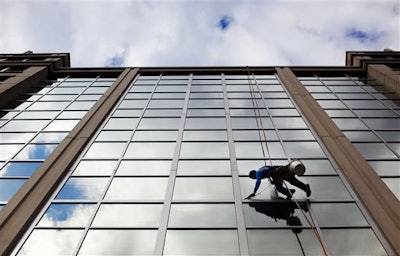
 U.S. employers added a robust 280,000 jobs in May, showing that the economy is back on track after starting 2015 in a slump.
U.S. employers added a robust 280,000 jobs in May, showing that the economy is back on track after starting 2015 in a slump.
The Labor Department said Friday that the unemployment rate ticked up to 5.5 percent from 5.4 percent in April. But that occurred for a good reason: Hundreds of thousands more people began seeking jobs in May, leading to the slight increase.
Last month's strong job growth suggests that employers remained confident enough to keep hiring even after the economy shrank during the first three months of the year. The government also revised up its estimate of job growth in March and April by a combined net 32,000.
Construction, health care and hospitality companies drove the May job growth. On the negative side, persistently cheaper oil led energy companies to shed workers for a fifth straight month.
Average hourly wages rose 2.3 percent from a year earlier, showing some pick-up. Still, pay is barely rising faster than inflation, a persistent problem for the economy that has limited growth.
Over the past three months, the economy has added an average of 207,000 jobs. That's a decent gain, though lower than last year's average of 263,667.
Prices for the benchmark 10-year Treasury note fell, pushing up its yield to 2.42 percent from 2.35 percent just before the jobs figures were announced. U.S. stock futures held steady.
While employers continue to hire, consumers, the main driver of the U.S. economy, remain fairly cautious. Factory orders have dropped. But Friday's solid jobs report confirms the economy's vitality.
Over the past 12 months, around 3 million jobs have been added. Those additional paychecks helped increase spending on housing and autos. Sales of newly built homes have surged 23.7 percent through the first four months of 2015 compared with a year ago, government data show. Rising demand for new homes led construction firms to hire 17,000 workers in May.
Americans bought 1.64 million cars and trucks in May, the most since July 2005. Manufacturers added 7,000 jobs last month, primarily in the auto sector.
Retailers hired 31,400 new employees. The health care sector added 57,700 workers, and the leisure and hospitality industry, which includes restaurants, hired 57,000.
Employers seem to be envisioning a healthier economy. The weekly number of people applying for unemployment benefits — a proxy for layoffs — has remained under a historically low 300,000 for more than four months. By holding on to nearly all their workers, businesses are ensuring that they will have the capacity to respond to greater customer demand.
But the economy faces other challenges. The dollar has appreciated about 19 percent in the past year against other major currencies. That trend has made U.S. goods costlier overseas, thereby squeezing exports and the U.S.-based branches of foreign companies.
Nor has cheaper gasoline delivered much help. Instead of sparking the wave of consumer spending that many economists had expected, a nearly 45 percent drop in oil prices since July has damaged a U.S. economy increasingly reliant on energy drilling. The energy industry has let go of workers and cut orders for pipelines and equipment.
The mining sector, which includes oil and gas, trimmed 17,200 workers from their payrolls last month.
The setbacks have been substantial enough that the International Monetary Fund on Thursday said it thinks the Federal Reserve should hold off on raising short-term interest rates until 2016. IMF Managing Director Christine Lagarde, saying a rate increase could disrupt the economy, urged the Fed to await signs of wage growth.
Fed Chair Janet Yellen has said she expects to raise rates this year if the economy continues to improve, thereby ending nearly seven years of record-low rates.
"At this stage this evident strength in the labor market probably isn't enough to persuade the Fed to hike rates by July, but it definitely makes a rate cut by September probable," said Paul Ashworth, chief U.S. economist at Capital Economics. "Only 24 hours later, the IMF's suggestion that the Fed should wait until 2016 looks very dated."
Falling unemployment usually leads to fewer people seeking work, forcing employers to boost wages. But plenty of people are still searching for jobs. The aftermath of the recession has left 8.5 million people unemployed and seeking work, about 1.3 million more than were jobless before the downturn began in late 2007.
Companies often increase pay when their workers become more productive. Yet productivity fell at a 3.1 percent annual rate in the first quarter — a sharper drop than the decline estimated a month ago, the government said Thursday.






















